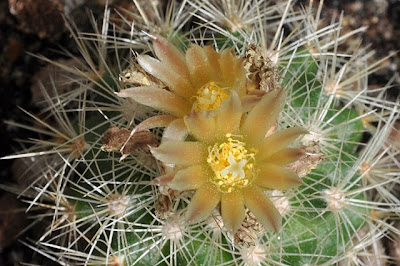To be honest, Acharagma roseana plants are not particularly ingratiating – the flowers are not breathtaking nor is the spination stunning. To me, the attraction of A. roseana lies in its close relationship with Lophophora and Obregonia, making it an obvious candidate for hybridization experiments.

Acharagma roseana flower with pale yellowish tepals with brownish pink midveins
Gene sequence studies by Butterworth et al. (2002) suggest that Acharagma belongs in a well-supported taxonomic clade with Lophophora and Obregonia. They sum up their results as follows:
LOPHOPHORA CLADE. Although there is strong support for this clade (87% bootstrap, 5 decay steps), few morphological features unite this clade. All members have napiform or carrotlike tap-root systems, although these features are also found in other members of the tribe.
The two species of Acharagma have been a source of taxonomic confusion. […] The rpl16 intron data suggest the removal of these two species from Escobaria, placing them in a well-supported (bootstrap 87%, decay 5) clade containing Obregonia and Lophophora, the latter shown to be polyphyletic based on this topology.
(the closing remark on Lophophora being polyphyletic is an interesting statement in its own right, but that’s a whole other story)

Acharagma roseana flower with pink tepals with darker red-tinged midstripe
In The New Cactus Lexicon, Hunt describes this species as Acharagma roseanum - I’m not sufficiently well-versed in the Latin language to say which form of the name is correct, but according to this site on botanical Latin the specific epithet must match the genus name in gender. As Acharagma is from the Greek a, without, charagma, groove (the gender of which, according to Hunt, is neuter) this would warrant the “-um” ending. I’m a firm believer in applied laziness so I’ll stick to the (apparently erroneous) “-a” ending for a wee bit longer and avoid having to re-label my plants ;-) Hunt accepts two subspecies: ssp. roseanum and ssp. galeanense, the latter having more spines and slightly larger, cylindrical bodies, compared to the egg-shaped body of the typical form.

Comparison of the two different color forms of Acharagma roseana flowers
The Acharagma roseana plants featured in this post were started from seed in 2005 and flowered freely last summer. As mentioned I would like to use these plants for hybridization experiments with Lophophora but I still need to come up with a good protocol for avoiding self-pollination. The locality information for these specific plants is: LX 578; Ramon Arizpe, Coahuila - “Ramon” should probably read “Ramos” but I'll stick to the information from the vendor’s seed list.

Acharagma roseana with fruits
Like most other parts of Acharagma roseana the fruits are not showy either. They are an inconspicuous yellowish green color, but have a surprising, not unpleasant, tart taste reminiscent of gooseberries.
The plants grow in my unheated greenhouse and I hope they survive the month long cold snap that is just now loosening its grip of Denmark.



















Very nice! Try crossing it with a Lophophora cactus! Supposedly they can create a hybrid!
ReplyDeleteNot entirely on topic, but accidentaly bumped into this picture from a mexican photographer on flickr:
ReplyDeletehttp://www.flickr.com/photos/26673777@N04/4437930303/in/photostream/
As you can see in the description, "Ramos Arizpe" is the name of a municipality/county, and a cactus-rich one, it seems.
Well, Sara. As the post says "I would like to use these plants for hybridization experiments with Lophophora but I still need to come up with a good protocol for avoiding self-pollination". The close relationship of Acharagma and Lophophora make them obvious "hybrid material", but I want to make sure that I'm not heralding a selfed Lophophora as a new hybrid ;-)
ReplyDeleteZ, thanks for the link. Yet another nail in the coffin of "Ramon Arizpe" ;-)
I know of a few other species which may be good for crossing with lophophora but what are you thoughts?
ReplyDeleteWhat genera besides this one will you attempt to cross with lophophora?
I'm aware of the alleged Turbinicarpus and Mammillaria / Lophophora hybrids but haven't really seen any convincing results. So I'll put my money on Butterworth and focus on Obregonia and Acharagma.
ReplyDelete